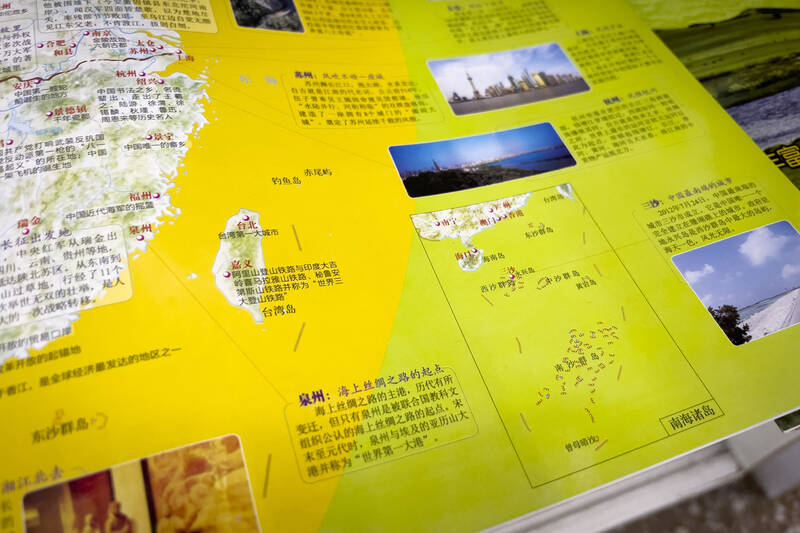China on Monday last week published a new version of its national map that extends its territorial claims in the Asia-Pacific region. The map angered neighboring states just before Chinese President Xi Jinping (習近平) was supposed to attend this weekend’s G20 summit in New Delhi.
Not only does the new map released by the Chinese Ministry of Natural Resources include 90 percent of the South China Sea with the controversial “nine-dash line” that the Permanent Court of Arbitration ruled unlawful in 2016, but it added a 10th dash to include Taiwan, an independent, sovereign nation that the People’s Republic China has never set foot on.
The map also claims contested areas along its southern border with India, such as Arunachal Pradesh, the Doklam plateau and Asaki Chin, as well as Russia’s northeastern Bolshoy Ussurisky Island, even though the two states signed an agreement in 2004 to split the island and Xi once pledged “a friendship without limits” to Moscow.

A new China map shows the South China Sea with nine-dash line claims under Chinese territory and a new line next to Taiwan are seen on the map, at a bookstore in Beijing, Friday, Sept. 1, 2023.China has upset many in the Asia-Pacific region with the release of a new official map that lays claim to most of the South China Sea, as well as contested parts of India and Russia, and official objections continue to mount.
Photo: AP
The revision, which aims to correct what China has in the past called “problematic maps” that it says misrepresent its territorial borders, was “a routine exercise of sovereignty in accordance with the law,” Chinese Ministry of Foreign Affairs spokesman Wang Wenbin (汪文斌) said.
China’s map has unsurprisingly outraged most of its neighbors, which have objected to Beijing’s claims over territories that fall within their exclusive economic zones. Manila said it was “the latest attempt to legitimize China’s purported sovereignty and jurisdiction over Philippine maritime zones with no basis under international law.” India lodged a strong protest with China, saying the map would only complicate attempts to resolve their deadly border dispute, especially after Xi and Indian Prime Minister Narendra Modi agreed just days ago at the BRICS summit in South Africa to de-escalate tensions.
Taipei has also refuted China’s claim and asserted that Taiwan, the Republic of China, is a sovereign and independent country that has never been subordinate to the People’s Republic of China. These are universally recognized facts and the “status quo” in the international community, regardless of how the Chinese government distorts its claims over Taiwan.
The map is obviously a provocation to make waves in those regions that China has long claimed for its so-called “historical rejuvenation.” Its ambitious imperialism ignores international rules and order.
Just as US National Security Council spokesman John Kirby said: “It’s not just what lines they draw on the map. It’s about their coercive behavior. It’s about the way they intimidate [their] neighbors and some of our allies and partners in the Indo-Pacific, to try to advance these false maritime claims.”
As Beijing’s new map was released just days before the ASEAN and G20 summits, the territorial disputes are likely to be discussed and resolutions sought. China persists in pushing its extravagant claims by advancing its irredentist view that it is regaining its territory, even though it should know it is only fueling tensions in the region.
China has announced that Xi is to skip the ASEAN Summit in Indonesia and G20 summit in India, even though he has attended every G20 leaders’ summit since taking power in 2012.
Xi’s absence further shows he is giving up the opportunity to speak with other leaders and marks a shift in his methods of international engagement. Just last year, during a meeting with US President Joe Biden at the G20 summit, Xi said that responsible statesmen should think about the ways of getting along with other nations, and in 2021 ASEAN, Xi pledged that China would not seek hegemony or bully its smaller neighbors.
China’s controversial map and its leader’s duplicity signal that the nation is nothing more than an irresponsible troublemaker in the Asia-Pacific region and the world.
Source: Taipei Times - Editorials 2023/09/06
| < Prev | Next > |
|---|




















